by Briscoe White | Jan 10, 2011 | Gardening, Herbs |

Though Rue’s rich history is merely a memory to many these days, this hardy perennial herb still has a lot to offer. From the mystical to the mundane, Rue has been a popular herb throughout time with many modern applications that are often overlooked. A flavorful herb to season your favorite dish when used sparingly, an attractive organic insect and pest repellent, and a powerful natural antispasmodic, Rue is a terrific aromatic herb for any garden.
Also commonly known as ” the Herb of Grace” or the “herbe a’la belle fille” (the Herb of Fair Maidens) in France, Rue has long been a symbol of virtue and purity. As part of traditional Lithuanian wedding rites, the bride wears a crown of Rue which is burned during the ceremony to symbolize her transition from the whimsy and virtue of childhood to the responsibilities of motherhood and adulthood. A sprig of Rue is also presented to the marrying couple to lend clarity to their marriage. In many parts of the world, Rue was also used to repel witches and evil spirits because of its strong, pungent odor and effect on the body. Sprigs of Rue were ingested to guard against spells, and was considered a very reliable “anti magic” defense. This belief started with Ancient Greeks who, when dining in the company of strangers, ate Rue to calm their indigestion, which they attributed to their new guests using witchcraft to cast spells upon them. Ironically, Rue was also used in witchcraft to create and cast spells. Because of the herb’s astringent and abortive properties Rue was used to poison, blister, and in some cases, make the victim of the spell miscarry. Rue was also used to give a person “second sight” and was believed to help see into the future. This old-world reverence of Rue as a sacred herb and guard against evil also manifests itself in the Catholic Church, where it is dipped in Holy Water during High Mass and then sprinkled over parishioners to bless them.
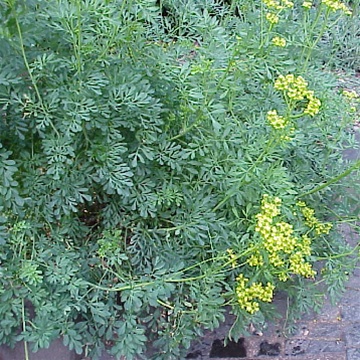
Also heavily used in art and literature, Rue is closely related to regret or remorse and even the word “rue” in its literal sense means to repent or lament. Mentioned by Milton, Shakespeare and in the Bible, in the Book of Luke, Rue is used as a constant symbol of guilt, sorrow and anguish. It was common to eat Rue among Italian artists, including Michelangelo and da Vinci, to sharpen their creativity and eye sight during tedious periods of painting or sculpting. The strong, bitter taste of the Rue was thought to awaken the senses and encourage productivity. This thought that Rue could aid eyesight was also shared by expert marksmen who coated their gun flints and bullets with a mixture that included Rue to make their aim more true.
Rue has lost its popularity as a modern medicinal herb because of its bitter taste, its ability to nauseate and poison if taken in too large a dose, and the difficulty to harvest it due to allergic reactions with the plant’s oil when combined with UV light. This phenomenon is called Phytophotodermatitis and can be contracted when your skin comes into contact with the Rue plant in direct light. The plant’s oils are activated by the light and can cause very painful blistering, rashes and skin irritation, similar to poison ivy. Characteristic of all members of the Citrus family, Rue shares this quality with Lemons, Oranges and Limes. The best way to avoid this painful reaction is to wear long sleeves and gloves when tending Rue and to harvest it early or late in the day when the sun’s rays are weaker. Washing affected areas quickly can help alleviate the reaction, as well as applying Aloe, Calendula or over the counter antihistamines directly to the points of contact. Rue was traditionally used for its powerful emmenagogic properties (an agent that encourages menstrual flow), by women suffering from various menstrual problems, but is no longer deemed a safe alternative to other herbal antispasmodics because of the high chance of miscarriage. This being said, Rue should never be handled or ingested by pregnant women.
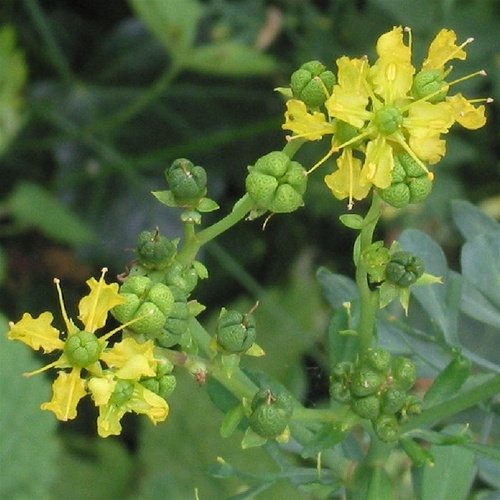
Rue’s most present-day use is in the kitchen as a culinary herb, and it is the staple of many cultural foods throughout the Mediterranean, Greece, Italy and Ethiopia. Used in small quantities, as it packs a potent punch and tends to overwhelm a dish easily, Rue is a strong, savory herb. When dried, the herb takes on a more bitter taste which comes from the presence of Rutin, a chemical also found in Watercress, Capers and Orange Peel. In Ethiopia, the leaves and berries of the Rue plant are used to create a traditional spice mix called Berbere and it is used in many Mediterranean recipes to lend a strong flavor to fish, cheese and meats. Because its taste is complimented by other savory herbs, Rue is a great addition to Italian recipes like tomato sauces that require Capers, Marjoram, Basil and Lovage. To lessen the bitterness of this multipurpose herb, extract just the oil from the Rue leaves by adding it in for a few minutes at the end of the cooking time, once your sauce or soup has reached a slight boil. Take the leaves out after a minute and discard, like when cooking with Bay leaves. This will maximize the flavor of the Rue while leaving the bitterness to a minimum.
Although we think of Rue as an outdated, old fashioned and even ancient herb, there are lots of reasons to still grow this wonderfully ornamental plant in your garden. Aside from its many practical and cultural applications, it’s a beautiful, yellow flowering perennial with broad, blue-green foliage. It acts as a natural insect, deer, cat and dog repellent and has a strong, citronella-like fragrance. Rue leaves were the basis for the club design on playing cards and will lend a lovely contrast to your gardenscape. A hardy herb, Rue will grow easily in well-drained soil and its verdant leaves will add lovely cover for surrounding plants. As Rue is making a graceful comeback, try planting it as a useful ornamental or buying it in bulk as a cut herb for culinary and spiritual purposes–the possibilities for this versatile herb are endless!
by Briscoe White | Dec 29, 2010 | Gardening, Inspiration, Life on the Farm |

Well, though it’s too cold to ship most plants for us here at The Growers Exchange, we’re still hard at work sowing and growing for the spring season. Neither wind nor rain nor sleet nor snow have kept us away (someone has to be here to stoke the wood stove that heats the greenhouse!), but it sure makes it worth while to see such wintry natural beauty! When we braved the roads to get to the office after a recent heavy snowstorm, we were greeted with a row of glistening icicles hanging like a frozen curtain from our porch roof.
The recent frigid temperatures have made it hard on any plants left out to fend for themselves, so how can you protect them when the forecast is calling for snow? Cold frames, hoop tunnels and extra mulching are great ways to protect your plants during the cold months. We use cold frames and tunnels to keep the frost from killing herbs like Rue, which we grow in one of our fields for medicinal, culinary and cultural usage. Many supplies needed to build these season-extending protectors, like old lumber or discarded window frames with the panes still intact, can be found laying around your garage or barn. Otherwise the necessary resources can be bought fairly inexpensively at your local hardware store.
Other easy cold thwarting tricks are to plant large, shrubby evergreens or a tough perennial like Rosemary ‘Hardy Hill’, around your garden to protect smaller, more vulnerable plants from icy winds. Positioning your gardens along a south facing wall of your home will also ensure that it gets lots of warmth from the sun as well as heat escaping from your home. For more information on building cold frames or hoop tunnels, check out some of the educational videos listed on YouTube.com, like this one that we found from gardenfork.tv:
How to Build a Cold Frame
by Briscoe White | Dec 22, 2010 | Basics, Containers, Flowers, Gardening, Herbs, Indoor Gardening, Miscellaneous |
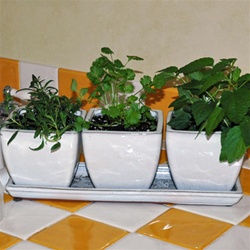
With winter here and in full force already (whether we like it or not), I’ve had to bring in a number of our outdoor plants. My first concern was to find space for all of the various sized pots and to make sure no one was going to trip over them. Once I had my living clutter settled in for the season, I began thinking about how to keep them healthy and happy throughout these long cold months, especially when we have everything from cacti to hardy herbs like Rosemary. Depending on what type of plants have moved into your home for the holidays, here are some general rules of thumb and just plain good advice for keeping them alive and well.
Lighting
We don’t think much about the amount of light outside as it changes from season to season, when we’re indoors and warm with electric lights, but this is a major factor for your plants. Especially with this time of year being the shortest amount of daylight we’ll see, you need to make sure your plants are getting the amount they need. Though probably dormant for the season, your flowering plants tend to like more light than evergreens, cacti and other foliage hardy plants. Whether you unsash your curtains, open the blinds or add additional artificial light, your plants will need a little UV boost through the winter. Even getting your hands on the best led grow lights will offer your plants with the right amount of sunlight that can help them to flourish in their surroundings. Make sure to turn them occasionally to allow all sides and leaves to get plenty of light. This will also help them from growing at a crooked angle, as most tend to grow towards a light source.
Water
If you’re feeling dried out from running your heat on high, chances are that your plants may be, too. Make sure to water them appropriately. Excluding cacti and other succulents, an easy way to tell if your plant needs water is to stick your finger partially into the dirt to test it. If it’s bone dry, don’t drown it. Water moderately and monitor its progress. If you find that your plants are needing water at alarming rates, check to see where you have them placed. On top of a radiator or next to your fireplace may be too hot for their liking.
Temperature
So, you’ve moved your little green friends indoors and you figure that should keep them safe from the temperatures, right? Think again. Some plants can be highly sensitive to heat and cold so make sure you aren’t placing your Basil plant near a cold, drafty vent or your Lemongrass right beside your wood furnace. Depending on their particular needs, temperature can even speed and slow the growth process for your plants, just like an artificial changing of the seasons. For example, with Amaryllises, because they are flowering bulbs, temperature plays a huge part in their growth cycle. We brought some in from the greenhouse for the holidays and the ones placed near our radiator bloomed in a week! I guess we tricked them into thinking it was Spring!
Cleaning and Prevention
Another great thing about having your plants close at hand when it’s too cold to go outside, is that you can’t help but to notice them. The winter months are a great time to get to know your plants’ personalities and to give them a good cleaning. Dust and microscopic debris build up on the plant’s leaves which can block sunlight and the plant’s pores. Try cleaning the tops and bottoms of your plant’s leaves with a damp cloth to remove any unwanted buildup that may be hindering your plant from being its healthiest. While you’re at it, take a close look for insects and disease. For a longer lasting plant, it’s best to nip an infestation or blight in the bud. In most cases, warm water and a mild soap will do the trick to remove many common pests. For a deeper rooted problem, try an all natural pesticide or fungicide, which can be bought at your local hardware store.
Positioning
Plants prefer a routine and moving them into your home can be quite an adjustment. To alleviate further disruption to their transition indoors, try to find permanent spots for them when you bring them in. If you can place them in areas where they won’t be disturbed by the hustle and bustle of the holidays, pets, kids or just because they’re in the way, they’ll greatly appreciate it. Moving potted plants too often can really disrupt and unsettle their soil and root structure. Leaving them to settle in and stay sedentary will cause the least amount of stress on them, as leaves, stems, flowers and branches can break, become weak or tear during the moving process. This will also allow the roots to stay strongly grounded, as soil won’t be jostled about, loosening the plant’s hold.
Potting
Making sure your plants are in the best pot or container is also crucial to its health. Think about it. When you start to outgrow your shoes, the constriction and tightness is uncomfortable, right? Well, many plants need to be moved to larger containers as they get bigger to give them more adequate space to stretch and grow bigger. The winter is a great time for this as the cool temperatures make the process less stressful on your plants. Give your plants plenty of room to grow and you’ll get to enjoy larger and longer lasting results.
Once the stress of the holidays has wound down, indoor gardening can be a terrific therapeutic hobby…or, during the holidays if you need an escape from the madness! Gardening, in general, can actually make for a very fulfilling past time as it can keep you productive, environmentally-minded, creative and, by growing your own produce, can actually save you money. For other hobby ideas, be sure to visit this website – https://tlhobbyideas.com. Gardening year round allows you to enjoy the fruits of your hard work constantly and the calming presence of your indoor plants will bring beauty and fresh aroma to these bleak winter days. Many plants can be easily started indoors during the colder months, for transplant in the spring to an outdoor garden. Try growing your favorite culinary herbs indoors this season to spice things up in your stews and other hearty recipes or just to lend a savory fragrance to your home. By growing now, you will be more prepared once spring gets here!
by Briscoe White | Dec 17, 2010 | Life on the Farm, Wildlife |
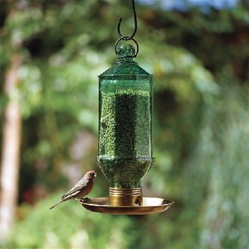
A Bird Buffet!
If your area is experiencing the extreme cold we here in Virginia have, you have probably not thought much about working in the garden. My yard is frozen solid so there is not much that could be done, even if one could stand the frigid temperatures.
Though working soil and plants is a long way off, there is one garden chore we can still do. Feed the birds. Birds don’t just make for an amusing source of natural entertainment, they’re also vital to your garden. Birds help keep your garden pest free while also spreading necessary pollen from plant to plant to aide in plant fertilization. Without these valuable winged friends, we’d be lost, so if you take care of them, they’ll take care of you (and your garden)!
Like many gardeners, I keep several bird feeders in the yard. During cold snaps like this one, the birds need all the help they can get, and respond quickly to any food offered to them. They empty my feeders quickly and sometimes eat it all before they can be refilled. When I go out to refill them, I hear birds chirping and singing as if they know what I am doing. And they do know because the feeders are occupied by the time I am back indoors. Other birds hear the commotion and pretty soon the trees around the feeders are full of birds trying to get to the feeders.
You can also spread seed or place fruit like apples and pears along your porch rails or strung together with a needle and thread and tied to a tree branch, for an added variety of food to attract different types of birds this winter! Try recording how many new varieties you come across and keep a bird journal of their favorite foods, habits, and personalities.
Try adding nesting boxes or bird houses around your yard to encourage your feathered friends to stay longer! Purple Martins, Gold Finches and Bluebirds, to name a few, are very appreciative of a safe, dry place to nest. You can even grow your own! Try growing gourds this year and let them dry. Cut a hole for an opening and hang it for a natural bird abode. Keep your houses and nesting boxes out of the reach of children and pets and do not disturb them for happier house guests.
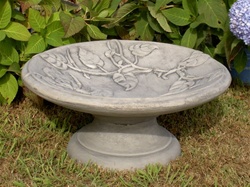
Birdbaths are good for more than bathing!
Even if it’s freezing out, birds also still need a clean water source. Try using one of our birdbaths this winter. You may have to break a little ice each morning to add fresh water, but we promise the birds will thank you. Place your feeders and birdbaths near your porch or window and enjoy the natural entertainment all year long!
Birds are an important part of my yard and garden, they bring action, color, and life. So do not forget them in these tough times and take time to feed the birds!
For more tips on feeding birds through the winter, check our article on caring for birds during the winter.
by Briscoe White | Dec 13, 2010 | Basics, Herbs, Life on the Farm |
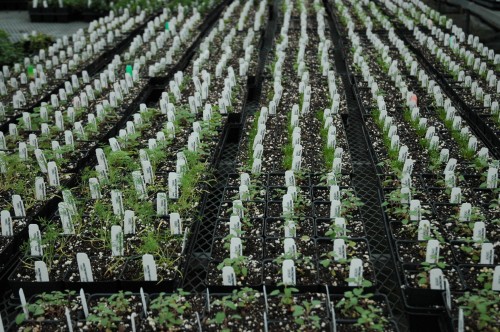
Our seedlings are growing strong!
Though the weather outside is frightful, spring planting can be delightful! Sounds strange, but that is what we are doing here at The Growers Exchange. Seeds were planted several weeks ago and many are now ready to transplant into their final pots. Some plants take a long time to grow from seed, so we start early to insure large well-rooted plants for planting out this coming spring.
Eucalyptus Silver Drop, Feverfew, Comfrey, and others require several months to gain the size and maturity they will need to grow even larger next summer. So, even though it does not feel like spring, we are busy getting ready for when it really does arrive.
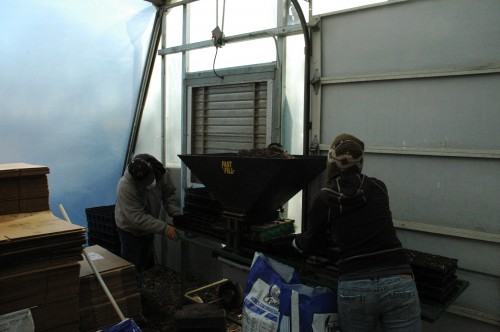
Ino and Annie filling flats!
A good indication of today’s weather is how the greenhouse staff is dressed while filling flats. I hope we don’t need that much clothing much longer!









